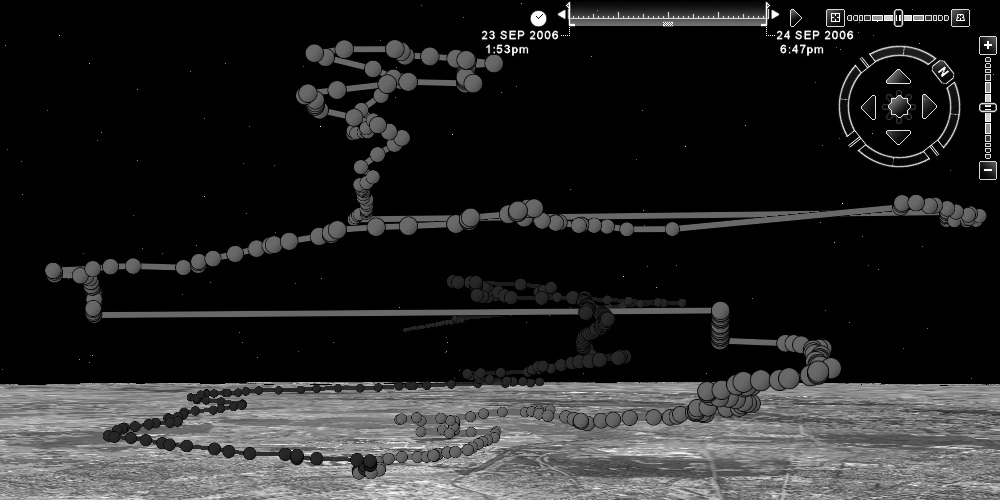Downloads
DOI:
https://doi.org/10.7480/rius.1.200Abstract
Various applications of geo-referenced information currently being developed are or will be both commercially and publicly available. These applications combine functions such as mobile communication, GPS, digital photography, e-mail, cartography, satellite imaging and internet access. One of the first applications of so-called ‘location based services (LBS)’ has been the tracking & tracing of convicts on parole and animal species in the wild. In the United States, web-based products are available that enable parents to trace the whereabouts of their children, so-called child monitoring services.
Locative media are also a powerful tool in the hands of urban investigators wishing to learn directly from users the specific routes they take and the locations or events they attend. Locative media can help to unveil the specific mental maps that an individual user has in his or her head. The experience and perception of a place or route can be reported by residents by means of short texts and photos.
We decided to further develop geographical research techniques such as Hägerstrand’s space-time path and diary analysis. In doing so we developed sense of the city as a method of providing insight into the simultaneous but diverse patterns and experiences of people in regard to time and space.
How to Cite
Published
Issue
Section
License
Copyright (c) 2008 Joanne Heyink Leestemaker, Leon van Berlo

This work is licensed under a Creative Commons Attribution 4.0 International License.
References
Arentze, T., Dijst, M., Dugundji, E., Chang-Hyeon, J., Kapoen, L., Krygsman, S., Maat, K. and Timmermans, H. (2001) New activity diary format: Design and limited empirical evidence, Transportation Research Record: Journal of the Transportation Research Board, No. 1768, TRB, National Research Council, Washington D.C., pp. 79-88.
AVV-MON (2006) Mobiliteitsonderzoek Nederland, Rijkswaterstaat Adviesdienst Verkeer en Vervoer, Rotterdam.
Boarnet, M.G. and Sarmiento, S. (1998) Can land use policy really affect travel behaviour? aAstudy of the link between non-work travel and land use characteristics, Urban Studies 35(7): 1155-1169.
Bohte, W., Maat, K. and van Wee, B. (2007) Residential self-selection, the effect of travel-related attitudes and lifestyle orientation on residential location choice; evidence from the Netherlands. Paper presented at the 11th World Conference on Transport Research, Berkeley.
Chung, E-H. and Shalaby A. (2005) A trip reconstruction tool for GPS-based personal travel surveys. Transportation Planning and Technology, 28(5): 381-401.
Doherty, S., Papinski, D. and Lee-Gosselin, M. (2006) An internet-based prompted recall diary with GPS activity trip detection: system design. Presented at 85th annual meeting of the Transportation Research Board, Washington, D.C..
Forest, T.L. and Pearson, D.F. (2005) A comparison of trip determination methods in GPS-enhanced household travel surveys. Presented at 84th annual meeting of the Transportation Research Board, Washington, D.C..
Golob, T.F. (2000) A simultaneous model of household activity participation and trip chain generation, Transportation Research B, 34, pp. 355-376.
Kochan, B., Bellemans, T., Janssens, D. and G. Wets. (2006) Dynamic activity travel diary data collection, using a GPS-enabled personal digital assistant. Presented at the innovations in Travel Modelling Conference, Austin, 2006.
Krizek, K.J. (2003) Neighborhood services, trip purpose, and tour-based travel, Transportation, 30, pp. 387-410.
Maat, K. and Timmermans, H. (2006) Influence of land use on tour complexity, a Dutch case, Transportation Research Record: Journal of the Transportation Research Board, No. 1977, TRB, National Research Council, Washington D.C., pp. 234–241.
Ohmori, N., Nakazato, M. and Harata, N. (2005) GPS mobile phone-based activity diary survey. Proceedings of the Eastern Asia society for Transportation Studies, 5, pp. 1104-1115.
Steer Davies Gleave and Geostats (2003) The use of GPS to improve travel data. study report. Prepared for the DTLR new Horizons Programme, submitted to the London Department for Transport, London.
Schönfelder, S., Axhausen, K.W., Antille, N. and Bierlaire, M. (2002) Exploring the potentials of automatically collected GPS data for travel behaviour analysis - a Swedish Data source. In: J. Möltgen and A. Wytzisk, eds, GI-Technologien für Verkehr und Logistik, IfGIprints, 13, Institut für Geoinformatik, Universität Münster, Münster, pp.155-179.
Stopher, P.R. and Collins, A. (2005) Conducting a GPS prompted recall survey over the internet. Presented at 84th annual meeting of the Transportation Research Board, Washington, D.C..
Stopher, P.R. and Wilmot, C.G. (2000) Some new approaches to designing household travel surveys – time use diaries and GPS. Presented at the 79th annual meeting of the Transportation Research Board, Washington, D.C..
Tsui, A. and Shalaby, A. (2006) Enhanced system for Link and mode identification for Personal Travel surveys based on Global Positioning Systems, Transportation Research Record: Journal of the Transportation Research Board, No. 1972, TRB, National Research Council, Washington D.C..
Wolf, J., Guensler, R. and Bachman, W. (2001) Elimination of the travel diary: an experiment to derive trip purpose from GPS travel data. Presented at 80th annual meeting of the Transportation Research Board, Washington, D.C..
Wolf, J., Oliviera, M. and Thompson, M. (2003) Impact of underreporting on mileage and travel time estimates: results from Global Positioning System-enhanced household travel survey, Transportation Research Record: Journal of the Transportation Research Board, No. 1854, TRB, National Research Council, Washington D.C., pp. 189-198.




